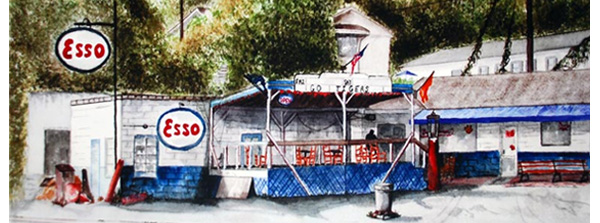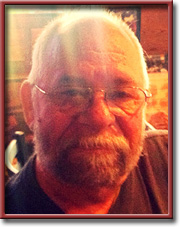William A. Balk, Sr.’s “Wartime Experiences of a Colorblind Navy Pilot—5.1”
“When I checked our fuel I realized I had another problem. We usually had enough fuel for about 30 minutes extra flying time after a long-range mission. I knew I was going to be at least 20 minutes late and that I would have to wait for them to re-spot the planes, turn the whole task force into the wind, get all the air operations crew back on the deck, and for the brass to start rehearsing how they were going to chew me out—if they decided to let me land.”—By William A. Balk, Sr.
Dispatches from The Esso Club
By Ted Balk
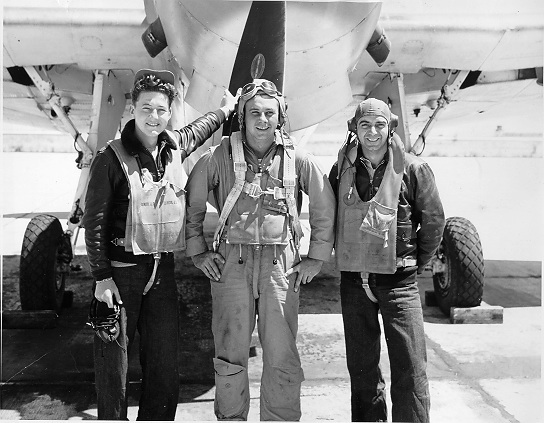
CENTRAL South Carolina—(Weekly Hubris)—8/11/2014—
CHAPTER II
Invasion of Palau
Conclusion
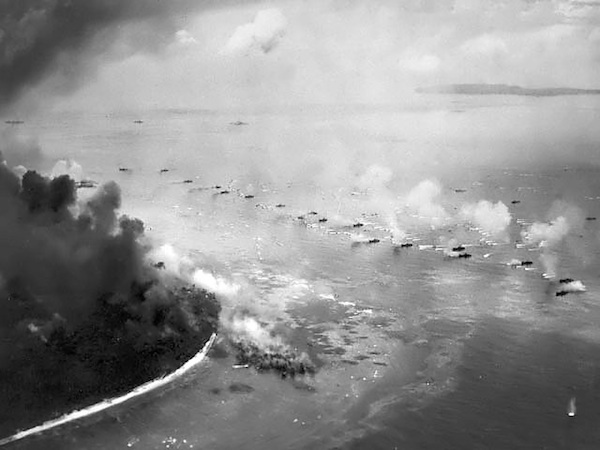
One of the unique features of Peleliu Island was a ridge of low hills located just inland from its west coast. This ridge did not extend far enough south to dominate the beachhead area, but when the Marines moved to expand their perimeter northward they ran into heavy sniper and artillery fire coming from this prominence.
It turned out that this ridge was riddled with caves overlooking the interior of the island, but these were so well camouflaged it was difficult to tell where the fire was coming from. Furthermore, due to the angles involved, neither bombs nor artillery could penetrate much beyond the caves’ mouths. This was a situation made to order for our HE rockets. After considerable bombing, the camouflage began to lose its effectiveness so, when we spotted an opening, we flew straight in at the cave’s elevation, then fired the rockets so that they would penetrate deep into the interior. This effort was greatly appreciated by the Marines on the ground, and the ridge later gained its claim to fame when they named it Bloody Nose Ridge.8
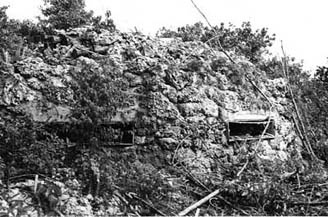
Earlier, I mentioned that I might be the only one in the squadron who ever got lost due to faulty navigation. This came about during the final days of our stay at Palau. I was assigned to make an ASP flight across the northern tip of the chain of islands, which was at a considerable distance from where our carriers were operating, off the southeastern tip. When I got there, I found a huge storm covering the entire area that I was supposed to patrol. I can’t say for sure this was a typhoon, but I estimated the winds on the perimeter to be about 50 knots.
Although this was called an ASP flight, its main purpose was to guard against any activity from the Japanese fleet, rather than to detect stray submarines. It was obvious that no sensible submarine commander would keep his boat on the surface of the sea I saw raging below me. I also doubted that a surface ship would stay there very long if she could help it. I tried to make radio contact with the air operations command to request permission to abort the mission but could get no response. I didn’t want to leave the area unguarded with no one informed, so I decided that we’d have to go into the storm. I told Jim that it was up to him because I couldn’t see a damned thing but the cockpit instruments.
We went into the storm and I navigated in the usual way, adjusting for wind direction and velocity to maintain course. I forgot one little thing, however. The wind direction within a storm has little to do with the direction the storm itself moves. Once you enter a storm, you become a part of the storm and move with it at its own velocity and direction. We bounced around in this mess for about two hours until it was time for us to head back to the ship. I headed south to get out of the storm and, sure enough, popped out right on schedule. The only trouble was, we weren’t where I thought we would be. When we went into the storm, the northern tip of the Palaus was plainly visible. When I came out, the only thing we could see was water.
Right away I realized what had happened, but I had no idea which way the storm had moved us and how far. It couldn’t have gone south or anywhere between southeast and southwest because the radar would have picked up some land signals. If I guessed it had gone 40 miles east, but it had actually gone 40 miles west, I would head home with an 80-mile error to start with. Fortunately, the carrier was equipped with a device called a YE-ZB, which transmitted a different letter of the Morse code in each of twelve sectors of the compass. These letters were changed daily, so it was necessary to have an up-to-date listing of the codes to be able to home into it. The signals were transmitted on a line of sight, so that the altitude at which the signal was picked up correlated with the distance from the ship.
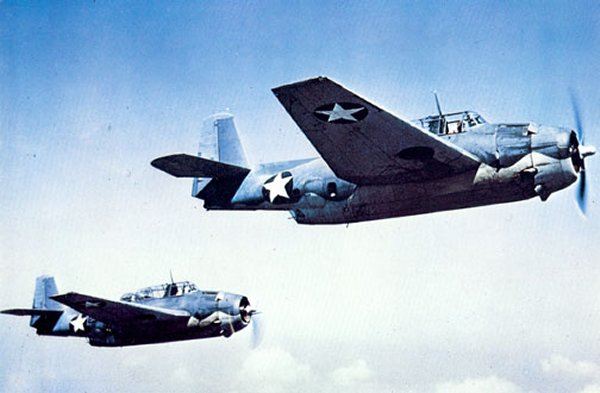
When we emerged from the storm I realized our only hope was to pick up the YE-ZB transmission. (I have no idea what YE-ZB stands for.) South seemed the only logical direction to head, so I headed that way and started climbing. At about 12,000 feet I picked up Morse code N (dash, dot), checked my code list for the day and got a heading—southwest, I think. From my altitude, I figured I was about 40 miles farther out than I should have been, which meant we were going to be late getting back on the ship. This put us in a serious situation. All planes in the air at any given time were expected to be back for landing at a specified time. The ships would then turn into the wind, launch planes scheduled for launching, and land those returning.
This was carried out as expeditiously as possible because the carriers had to maintain a constant course and speed during this operation and, consequently, were more vulnerable to a submarine attack. Also, as soon as landing operations were over, the plane handlers began relocating the planes on the flight deck for the next launching. This meant that the landing area was soon covered with planes so that if a late plane had to be taken aboard it created considerable confusion and uncomplimentary remarks. I don’t recall anyone else ever coming back late, although I am sure they must have. I did, twice, and came in early once, which is just as bad.
To get back to our situation after coming out of the storm . . . now I had a course and distance, but when I checked our fuel I realized I had another problem. We usually had enough fuel for about 30 minutes extra flying time after a long-range mission. I knew I was going to be at least 20 minutes late and that I would have to wait for them to re-spot the planes, turn the whole task force into the wind, get all the air operations crew back on the deck, and the brass to start rehearsing how they were going to chew me out—if they decided to let me land.
So I started doing everything I could to conserve fuel. I reduced propeller rpm to the minimum, reduced air speed, and established a rate of descent so that I’d drop from 12,000 feet to sea level at the same time I got to the ship. When I finally got them to answer on the radio I requested permission for emergency landing. They wanted to know why. I said I was low on fuel. They said how low. I said my gauge read ten gallons. (Normal consumption was about 50 gal/hr; take-offs and landings were considerably higher.) They said to stand by.
At this point, they hadn’t figured out that I was late coming in from a previous flight (they hadn’t missed me, yet); they thought I was from a more recent launching so they were suspicious that I was trying to get away with something. After a while, I called them on the radio again. They wanted to know what was wrong now. I reported that I now had eight gallons of fuel. They replied, “Roger, stand by.” Nothing happened. I called again and said I now had six gallons. They started moving the planes on the deck, then started turning the ship into the wind. I figured I had enough fuel for one pass. If I got a wave off, we’d probably end up in the ocean. Edinger and Pagnotta knew this, too, but I knew they were ready for whatever happened.
Everything went off without a hitch. As soon as the plane stopped, Commander McElroy was on the bridge shouting through his bullhorn. “Check his fuel. Get a can and drain it so you can measure it.” They got a total of three gallons out of all three tanks. Later, the Skipper asked me what happened. I told him and that’s the last I heard of it.
Shortly after this, our presence at Palau was beginning to become superfluous and we started to relax. The airfield on Peleliu had been “secured” enough to get the runways patched, but the Japs were still holding on within rifle range. The Marines had moved a squadron of F4U Corsairs in and started taking over the ground support operations. We could afford to take a breather.
With all of this relaxation going on, some of the big brass on the ship decided it would be a good time for them to acquire some Jap war souvenirs. The Admiral, Captain, Executive Officer, and Air Officer each rounded up a bunch of items for trade, such as cartons of cigarettes, bottles of brandy, etc., to trade with Marines for Jap flags, guns, pieces of uniform, whatever. I was designated to fly this stuff over to Peleliu and trade for whatever I could get.
When we landed on Peleliu, a voice on the radio directed me to a parking area on the side of the field nearest Bloody Nose Ridge. We were the only plane in this area. The Marine Corsairs that weren’t flying were parked on the other side of the field, away from Bloody Nose Ridge. As soon as we parked, a group of tough looking Marines showed up to welcome us aboard. They were curious about the plane, wanted to get in it, go for a ride, and one said if I would let him he could probably take it off and land it.
I decided right then that we couldn’t leave the plane unattended—they would probably try to steal it. Some of them invited us to visit their “hootch,” where they had coffee and “snacks.” Jim and Al went off with them in hopes they would come up with some souvenirs. The hootch turned out to be a muddy hole in the ground covered over with tarps. These guys also informed us that we were parked in rifle range of the Japs on Bloody Nose Ridge but that they weren’t shooting right now. If they started shooting we were welcome to take cover in their hootch. They didn’t have much to offer in the way of souvenirs but we got what we could for the Brass, and I managed to get a US carbine for myself. I still have it and it’s a great deer rifle. One of the Marines traded it for a carton of cigarettes. It had belonged to his buddy who had been shot the previous day.
Before we could leave, a storm moved in and it started raining, with zero ceiling. The temporary control tower the Marines had set up wouldn’t OK a take-off, so we were stuck on the island until the storm moved on. While I was sitting under the plane waiting for the weather to clear, a jeep pulled up and a Marine officer walked over to the plane. I think he was a general and in charge of one of the fighting units. He wanted to express his appreciation for our work.
He knew Admiral Sample and Captain Greber and was happy to learn they were in our outfit and asked me to express his appreciation to them also. He went on to say that he was particularly impressed with the squadron that had the diamond on the tail and that’s why he stopped by to talk to me. I told him we appreciated his confidence in us and it was a pleasure to work with his men. We shook hands and he left. Shortly after that, the clouds lifted and the Corsairs took off. They didn’t even bother to retract their landing gear. They made a slight turn at the end of the runway, fired their rockets into the caves, circled back and landed, re-armed, and did it again and again and again. We squeezed in our take-off between theirs.
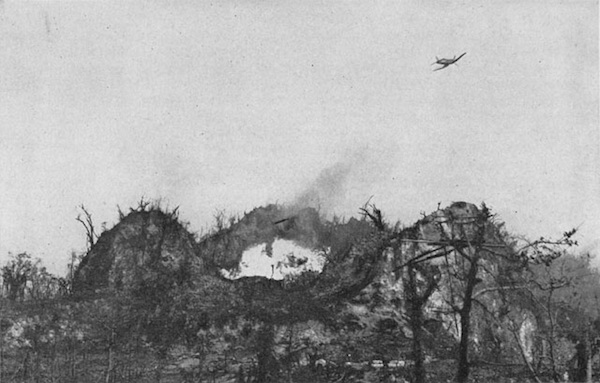
When I got back to the ship, I was late again. I requested permission to land: no emergency this time; I had plenty of fuel. They immediately turned into the wind, and I landed and delivered the souvenirs and the messages. This time, I was chewed out for not breaking radio silence to tell them I would be late and why. Other than that, everybody was happy.
My flight log shows that during the ten-day period of September 12 to September 23, 1944, we flew 16 combat missions for a total of 60.3 hours flying time. Of these, eight were low-level observations or photo missions. During the entire operation from September 8 to 29, we flew 20 missions involving 73.1 hours of flying. This was probably typical of each TBM pilot and crew in the squadron. Loose Ends reports that the squadron as a whole put in 1,540 combat hours during the first twelve days, and 1,878 hours during the whole operation.
. . . to be continued.

End Notes for Chapter II
Note 8. Bloody Nose Ridge
Bloody Nose Ridge remained a problem for the ground troops after we were relieved of close air support duties and replaced by a Marine Air Group flying Corsairs. The Corsairs continued with the tactic of firing high-explosive rockets into the cave entrances, but the Marines soon discovered that all the caves were interconnected by a massive tunnel system: the rockets would temporarily plug one entrance, but the overall operation of the complex was barely affected. The task of neutralizing Bloody Nose Ridge fell to the riflemen with their flame-throwers, hand grenades, tommy guns, carbines and bazookas.
The final cost of victory at Peleliu-Anguar greatly exceeded expectations in both casualties and time required. Preliminary estimates had projected securing the islands within about two weeks’ time, which meant that by 30 October the major fighting should have been completed. However, it wasn’t until 25 November that all organized resistance ceased. The Japanese lost about 13,600 casualties, resisting to the last man. The American losses were 950 killed and 8,500 wounded.
